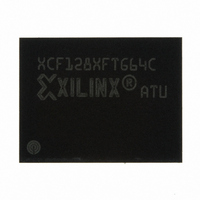XCF128XFTG64C Xilinx Inc, XCF128XFTG64C Datasheet - Page 35

XCF128XFTG64C
Manufacturer Part Number
XCF128XFTG64C
Description
IC PROM SRL 128M GATE 64-FTBGA
Manufacturer
Xilinx Inc
Datasheet
1.XCF128XFTG64C.pdf
(88 pages)
Specifications of XCF128XFTG64C
Memory Size
128Mb
Programmable Type
In System Programmable
Voltage - Supply
1.7 V ~ 2 V
Operating Temperature
-40°C ~ 85°C
Package / Case
64-TBGA
Access Time
85ns
Supply Voltage Range
1.7V To 2V
Memory Case Style
FTBGA
No. Of Pins
64
Operating Temperature Range
-40°C To +85°C
Svhc
No SVHC (15-Dec-2010)
Package /
RoHS Compliant
Lead Free Status / RoHS Status
Lead free / RoHS Compliant
Other names
122-1578
Available stocks
Company
Part Number
Manufacturer
Quantity
Price
Company:
Part Number:
XCF128XFTG64C
Manufacturer:
XILINX
Quantity:
319
Part Number:
XCF128XFTG64C
Manufacturer:
XILINX/赛灵思
Quantity:
20 000
Block Locking
Platform Flash XL features an instant, individual block-locking
scheme, allowing any block to be locked or unlocked with no
latency. This locking scheme has three levels of protection:
•
•
•
The protection status of each block can be set to Locked,
Unlocked, and Locked-Down.
the possible protection states (WP, DQ1, DQ0), and
page
Reading a Block’s Lock Status
The lock status of every block can be read during the Read
Electronic Signature mode of the device (see
Electronic Signature Command," page
reads at the address specified in
the protection status of that block.
The lock status is represented by DQ0 and DQ1. DQ0
indicates the Block Lock/Unlock status and is set by the
Lock command and cleared by the Unlock command. DQ0
is automatically set when entering Lock-Down. DQ1
indicates the Lock-Down status and is set by the Lock-Down
command. DQ1 cannot be cleared by software, only by a
hardware reset or power-down.
Block Lock States
Locked State
The default status of all blocks on power-up or after a
hardware reset is Locked (states (0,0,1) or (1,0,1)). Locked
blocks are fully protected from program or erase operations.
Any program or erase operations attempted on a locked
block returns an error in the Status Register. The status of a
locked block can be changed to Unlocked or Locked-Down
using the appropriate software commands. An unlocked
block can be Locked by issuing the Lock command.
Unlocked State
Unlocked blocks (states (0,0,0), (1,0,0) (1,1,0)) can be
programmed or erased. All unlocked blocks return to the
Locked state after a hardware reset or when the device is
powered-down.
The status of an unlocked block can be changed to Locked or
Locked-Down using the appropriate software commands. A
locked block can be unlocked by issuing the Unlock command.
DS617 (v3.0.1) January 07, 2010
Product Specification
Lock/Unlock – this first level allows software only
control of block locking.
Lock-Down – this second level requires hardware
interaction before locking can be changed.
V
protection against program and erase on all blocks.
PP
77, shows a flowchart for the locking operations.
= V
PPLK
R
– this third level offers a complete hardware
Table 18, page
Table 9, page 21
14). Subsequent
38, defines all of
"Read
Figure 43,
output
Platform Flash XL High-Density Configuration and Storage Device
www.xilinx.com
Locked-Down State
Blocks that are Locked-Down (state (0,1,x)) are protected
from program and erase operations (similar to locked
blocks) but their protection status cannot be changed using
software commands alone. A locked or unlocked block can
be locked down by issuing the Lock-Down command.
Locked-down blocks revert to the Locked state when the
device is reset or powered-down.
The Lock-Down function is dependent on the Write Protect
(WP) input pin. When WP = 0 (V
Down state (0,1,x) are protected from program, erase and
protection status changes.
When WP = 1 (V
(1,1,x), and locked-down blocks can be individually
unlocked to the (1,1,0) state by issuing the software
command to erase and programme.
When the Lock-Down function is disabled (WP = 1), blocks
can be locked (1,1,1) and unlocked (1,1,0) as desired.
When WP = 0. Blocks previously locked-down return to the
Lock-Down state (0,1,x), regardless of any changes made
while WP = 1.
Device reset or power-down resets all blocks, including
those in Locked-Down, to the Locked state.
Locking Operations during Erase Suspend
Changes to block lock status can be performed during a
suspended erase by using standard locking command
sequences to unlock, lock or lock-down a block. This
capability is useful in the case when another block needs to
be updated while an erase operation is in progress.
Three steps are needed to change block locking during an
erase operation:
1. An Erase Suspend command is issued.
2. The Status Register is checked until it indicates that the
3. The desired Lock command sequence is issued to a
After completing any desired lock, read, or program
operations, the erase operation is resumed with the Erase
Resume command.
If a block is locked or locked-down during a suspended
erase of the same block, the locking status bits are changed
immediately. But when the erase is resumed, the erase
operation completes. Locking operations cannot be
performed during a program suspend.
erase operation is suspended.
block (lock status changes).
IH
), the Lock-Down function is disabled
IL
), blocks in the Lock-
35





















